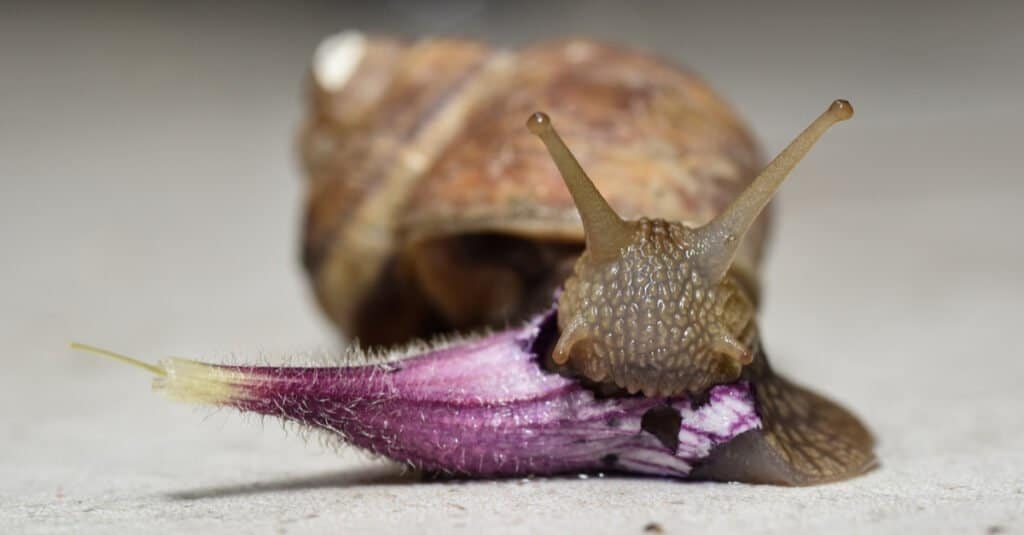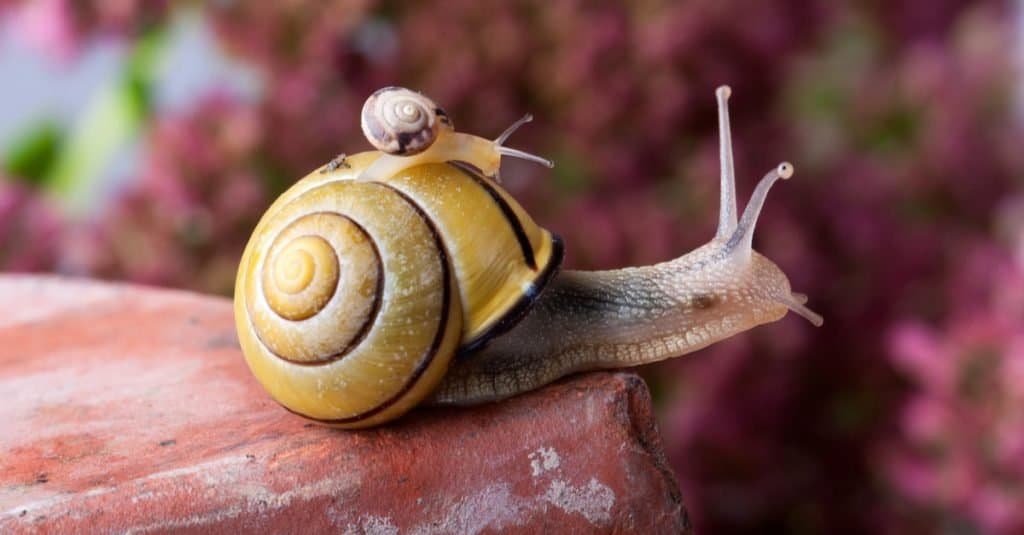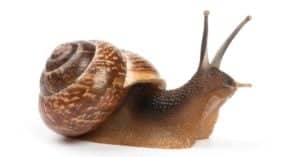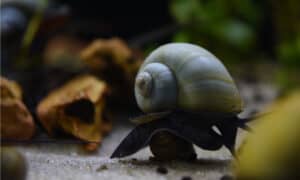
Commonly found in backyard gardens throughout the world, snails live a very interesting life. But how long do snails live, and what is the average life cycle like for a snail? These creatures are very unique, and many facts about them may surprise you!
In this article, we will go over the lifespan of the average garden snail, what they have to go through in order to breed and continue their species, and how their lifespan compares to other potential garden pests. If you’ve always wanted to learn about snails, read on to learn more!

Snails are unique in that you can tell how old a snail is by looking at its shell.
©iStock.com/Daniela Schröder
How Long Do Snails Live?
Snails typically live 2-5 years in the wild. Some of the larger species live up 15 years and up to 25 years in captivity. While this answer may surprise you, without the threat of predators or other environmental concerns, the average snail can live a long life.
Snails are unique in that you can tell how old a snail is by looking at its shell. It maintains the same shell that it was born with and gains more rings in its shell every time it grows. It is similar to a tree in this way, and we can look at the markings on a snail shell to know how old exactly a snail might be.
While not very many people keep pet snails or snails in captivity, this is where a snail has the highest chance of survival. Without natural predators, habitat loss, and the dangers of their environments, snails have surprisingly high life spans.
Lifespans vary between different species of snail, with some small aquatic snails living only a year or two. Most large land snails can live over five years, whether or not they are in captivity, and large sea mollusks have the potential of living hundreds of years.

.
©Guillermo Guerao Serra/Shutterstock.com
The Average Snail Life Cycle
If snails are capable of living for so long, does their life cycle have something to do with this? Let’s learn more about the average snail’s life cycle so that we can fully understand what they go through, from egg to old age.
Egg
The average snail Lays anywhere from 50 to 400 eggs during their breeding season. Snails are hermaphrodites, which means they are capable of supplying both sperm and eggs, regardless of gender. However, they do still breed with one another and lay their eggs during a specific time of year depending on the species.
Many land snails build a nest or protected area to lay their eggs in. This involves them digging a small hole in the dirt and allowing their eggs to be protected by a few layers of plant matter. However, this is usually not enough to allow all of their eggs to survive, and many snail eggs never hatch.
It takes anywhere from a week to a month for all snail eggs to hatch. These animals grow inside of their eggs as tiny snails, complete with their signature soft shells that will remain with them throughout their entire lifespan.

Without natural predators and the dangers of their environments, snails have surprisingly high life spans.
©microcosmos/Shutterstock.com
Young Snails
Once a snail is hatched, it immediately begins eating the egg that hatched from. It is common for many land snails to be born in a nearly transparent shade, and their shells are so soft that they cannot offer the snail any protection.
This is one of the many reasons why they eat the eggs that they hatch from. These eggshells are full of valuable nutrients and calcium, which is key to developing a hard and protective snail shell. If a snail is able to consume enough calcium and grow stronger, it is more likely to survive during this dangerous period of its life.
Adult Snails
There isn’t really a set age that a snail becomes an adult snail, though many people would argue that it is when the snail reaches sexual maturity. This can happen anywhere from a few weeks to a few months, depending on the species of snail.
You will recognize adult snails by their larger size, hardened shell, and many rings on that shell. Snails are constantly going through transformations, growing their softer body along with their outer shell year after year.
Speaking of the soft bodies of snails, what’s the difference between snails and slugs, especially when comparing their lifespans? Let’s learn more about these differences now!
How Does Their Lifespan Compare to Slugs?

It is common for many land snails to be born in a nearly transparent shade, and their shells are so soft that they cannot offer the snail any protection.
©Nailia Schwarz/Shutterstock.com
When it comes to garden pests, snails and slugs are often up there as the most annoying and most difficult to take care of. But this doesn’t mean they aren’t valuable to a garden environment and ecosystem, and controlling their lifespan is not something humans should be responsible for.
Speaking of life spans, how does the lifespan of a snail compare to that of a slug? We already know that snails can live a surprisingly long time, whether or not they are in captivity. The life of the slug is a bit different.
On average, slugs live anywhere from six months to two years, depending on the species and relative protection of their environments. Predation is the biggest threat to a slug’s lifespan, and this usually comes in the form of birds, other insects, and even humans interfering.
While a snail shell doesn’t offer very much protection in the grand scheme of things, it may be one of the many reasons why snails have a longer lifespan than slugs do. Slugs have no protection, don’t move particularly quickly, and are a favorite food of many wild animals.
However, slugs are also hermaphrodites and breed in a very similar way to snails. They maximize the number of eggs that they can lay at a time, and they are able to find protection in dirt, plants, and other outdoor environments, just like snails do.
The photo featured at the top of this post is © iStock.com/Daniela Schröder
Thank you for reading! Have some feedback for us? Contact the AZ Animals editorial team.






